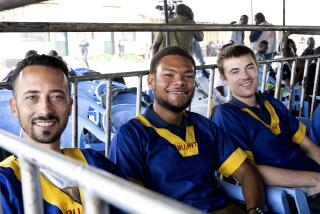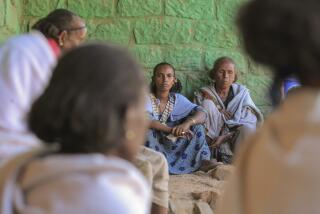COLUMN ONE : A Day of Reckoning in Ethiopia : The men of ‘The Red Terror’ will go on trial for an era of murder and torture that they recorded in chilling detail. They also face charges that they used famine as a weapon against their own people.
- Share via
ADDIS ABABA, Ethiopia — They killed, tortured, despoiled and terrorized an ancient country--and wrote it all down. In ghastly detail. They affixed their signatures and stamped the official seal to their 17 years of tyranny and filed it away. Then they lost a civil war.
Now, their deeds are counted on 309,215 pages, which become court evidence as the new government of Ethiopia today commences prosecution of 3,400 officials of yesterday’s Communist regime on charges of “crimes against humanity” and a roll call of other malefactions.
With the help of the American Bar Assn. and governments on three continents, Ethiopia believes it is undertaking the largest, most richly documented trial of systematic government genocide since World War II.
The number of victims could exceed 100,000. The number of ready witnesses could reach 10,000. The charges against the first string of defendants consume 296 leather-bound pages and require a full day to read aloud. About 1,300 men are in custody; 1,100 are on bail. The remainder have fled and are being sought. The process could last years.
Unique among the accusations is that the government of exiled President Mengistu Haile Mariam withheld and manipulated food aid in one of Ethiopia’s periodic droughts, employing the cruelty of famine as a weapon to suppress dissent.
The trials are probably the ending chapter of the last hard-line government to rise under sponsorship of the former Soviet Union. All across the exhausted, impoverished and struggling nation, Ethiopians are transfixed and wishing for catharsis. They hope, too, that in this improbable place, the world will find a precedent for trials of human rights atrocities in Rwanda and Bosnia-Herzegovina.
“I never thought this day would come true,” said Tsadle Wodajo, 58, a mother who lost a 20-year-old son to the former rulers they call the Dergue, or “the shadow.”
In her mud-and-straw home in a village in central Ethiopia, she recalled a police lieutenant warning her not to cry or mourn her boy’s 1978 execution, because that itself would be a counterrevolutionary crime and she would be imprisoned. So she held a wake quietly in the dark of night and fed the leftover ceremonial bread to her dogs to hide the evidence of her grief.
Terefe Atomsa, 73, also lost a son. In his cracked, yellowed block house outside Addis Ababa, among flowering jacarandas and fragrant eucalyptus, he recalls seeing a pile of corpses left on a bridge for all the living to witness. It was the government’s way of warning political opponents.
Terefe said he was afraid to claim the body of his 19-year-old son, recalling, “They would have made me pay for the bullets used to kill him.”
Meanwhile in the heart of the city, at the prison named Alem Bekayne--”the end of the line”--the gates were opened last week for two American reporters to enter a two-story octagon blockhouse.
Here, 420 defendants, including top officials of the accused Mengistu government, lounge in the warm sun, play Ping-Pong, study auto mechanics and wait for their turn in the dock and their chance to answer for an epoch that Ethiopians call “The Red Terror.”
The rooms offer courtyard balconies, a shaded square, running water and plenty of books, games and clean clothing. Many Ethiopians might find it strange to know that the prisoners live better than millions of ordinary citizens in this, the second-poorest nation in Africa, a country where 40% of its 55 million people have no work and where every street corner teems with beggars.
The first defendants to go on trial and those facing the most serious genocide charges are 66 men--45 in custody, the others, including the exiled Mengistu, being prosecuted in absentia. All face death by hanging, if convicted.
Among those in custody is former Prime Minister Fikire Selassie--seen last week sunning himself on a prison balcony, wearing sharply pressed slacks and a clean sweater. His face was impassive and his steel-gray hair carefully trimmed.
“Myself, I hope no good comes to them,” says prison administrator Theodore Makonen. “They have destroyed a country. They destroyed the lives of millions of people. And they do not feel sadness. They feel as if they were right.”
How detailed is the evidence against the accused? “We have minutes of meetings in which it is stated, ‘We hereby agree that revolutionary measures be taken against A, B and C.’ In this context you should know, revolutionary measure was a synonym for execution,” said Abraham Tsegaye, of the Ethiopia Special Prosecutor’s Office.
“These documents,” he added, “specify where the executions should occur, whether in a marketplace before the public or in prison or at the victim’s home. . . . And we have documents in which it is reported back things like, ‘I hereby confirm that your order for the execution of A, B and C was carried out in the presence of comrade so-and-so and comrade so-and-so.’ ”
Prosecutors also assert that the meticulous bureaucrats of the Mengistu government left behind taped recordings of torture sessions. There are known to be repositories of skeletons. Reports circulate widely that prosecutors have gory photographs and even videotapes of tortures and executions. “This was a campaign of annihilation against all political groups and individuals suspected of being counterrevolutionaries,” Tsegaye said.
These trials and these prisoners are the legacy of a brutal civil war rooted in the Cold War politics of the 1970s.
After 50 years under Emperor Haile Selassie, a dissipated Ethiopia fell to a military coup in 1974. The proud country is one of the oldest independent nations in the world, and its new rulers were befriended by the West. For a moment, Ethiopia thought it saw a spark of economic revival.
But the new rulers, searching for a way to control their people, soon moved into the Soviet orbit with its ideology of class struggle. They fashioned perhaps the most rigidly Marxist society in Africa. According to the special prosecutor, the government systematically executed hundreds of students on a single day to forestall a street demonstration. And 600,000 Ethiopians were forcibly relocated. Billions of dollars in aid were spent enlarging the army from 50,000 troops to 500,000.
Friends spied on friends, neighbors feared neighbors. Everyone was apt to be an informer. Deeply rooted Coptic Christianity was suppressed. Tens of thousands fled the country--the hope of a whole generation disappeared from the Horn of Africa.
And the outside world paid hardly any attention.
But ethnic dissent in several rural regions could not be crushed, despite the iron boot of terror, and the situation disintegrated into civil war in the 1980s.
A united opposition army took Addis Ababa and the country in 1991, and Mengistu fled to Zimbabwe. A new government, part socialist and part free-market, emerged under interim President Meles Zenawi. It sought to piece back together a country where regional and ethnic passions had been fanned to a fever pitch and where the very institution of government lacked credibility.
This new administration itself has an imperfect human rights record but has won renewed respect and contacts with the West.
A luxury hotel is under construction in Addis Ababa. It is spring here, and the year is 1987 by the Ethiopian calendar. The sky is pure blue, the breezes gentle. Just this week, an elected Assembly finished work on a new constitution that promises democratic elections within a few months.
On the streets, where there is heartbreaking poverty and there are an estimated 20,000 or more wandering children, beggars ask for the smallest of coins but will settle for a smile and the respect shown by a short conversation. The better restaurants serve lobster and Italian wine. A restaurant called Burger Queen has a fresh coat of white paint.
The genocide trials, says Addis Ababa Police Commissioner Hassen Shiffa, “are the first happiness the people have had. . . . Maybe they can re-create some confidence in government. The lesson is this: Rulers may be arrogant and kill, but one day they will have to come to court and answer.”
The epic storehouse of evidence and the legal case were compiled with help from several nations. Argentina provided forensics investigators at mass grave sites. The Americans and Swedes provided computer equipment and assistance for cross-referencing of documents. The British and Dutch provided money.
But the tribunal is wholly Ethiopian.
There are fewer than 1,000 lawyers in Addis Ababa, a city of uncounted millions of people; defense attorneys say they are swamped. Abebe Worke thumbed through the book of charges and began reading random pages: “Genocide, homicide, homicide, first-degree homicide, homicide . . . “
Even on the eve of trial, Abebe said he was unsure how many men the government would ask him to represent. It is unpopular work. His friends argue that the Dergue was so awful it deserves no defense, and he noted, “You can imagine what the aggrieved people feel here.”
In some quarters of Addis Ababa, the trials are quietly criticized as just another coldblooded attempt by one clique of African rulers to eliminate its predecessors.
In fact, among the charges against the Mengistu Dergue is that it executed its predecessor government, including the top 60 officers of Emperor Haile Selassie’s administration. And while most accounts say the emperor himself died of old age while under house arrest, today’s defendants now are accused of his killing too.
In a comfortable downtown Addis Ababa home, behind gates and a rutted road, Elizabet Mengesha sits in the dim light cast by bare bulbs and weeps for her husband, Debeta Dinsa, one of several men to serve as vice president under the former regime. Twice each day, she takes him food at the prison courtyard. She protests his innocence.
“I was a young woman then, but I did hear that people were dying in the streets. Yet I know my husband was a loving and caring human being,” she said. “I’ve been waiting so long for these trials. . . . If the government can convince the people that these men are criminals, then they have to go to jail. But true justice is the judgment of the people.”
Ethiopians now are taking to the streets to condemn the Dergue.
More than 2,000 victims marched here last weekend, hundreds carrying yellowing photographs of lost children, husbands, wives, fathers and mothers. It was as if the living and dead were marching together. Others in the crowd bore the scars of bullets, ropes, whips and scalding irons--and deeper wounds still to their dignity.
Melaku Tefera, 33, hobbled along using a crutch. His leg and sex organs were mutilated in prison. His father was executed. “These cruel people, these Dergue,” he said, “they shouldn’t be killed. They should be put in a museum behind bars. People from all over the world should have to come see them and know what they did.”
More to Read
Sign up for Essential California
The most important California stories and recommendations in your inbox every morning.
You may occasionally receive promotional content from the Los Angeles Times.










